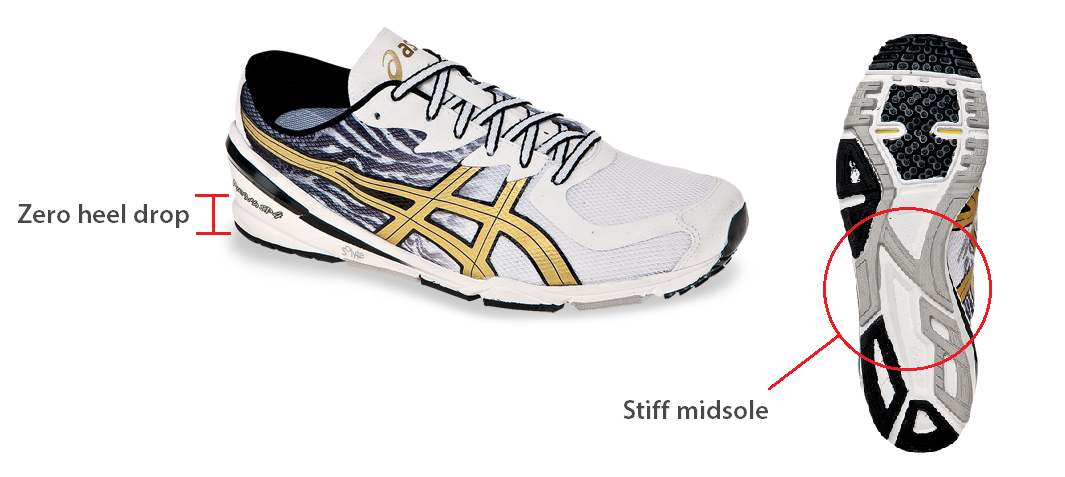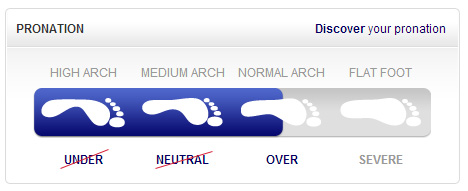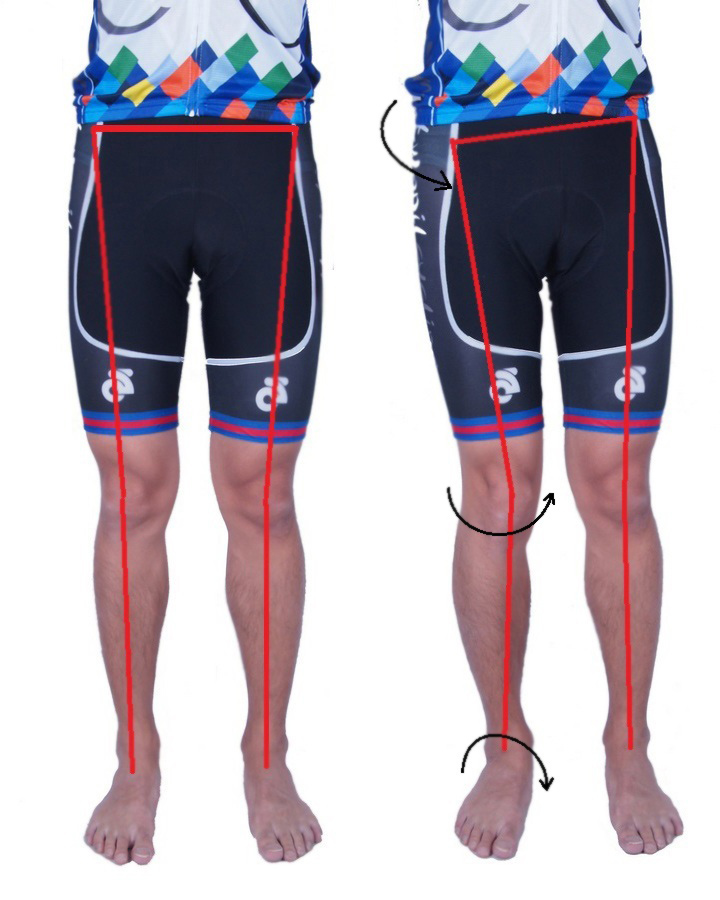
Running

The purpose of this page is to analyze the rationale of barefoot running, the biomechanics advantages of forefoot striking and the misconception of using minimalist shoes.
Biomechanics advantages of forefoot Strike over heel Strike
Before making judgment on which running style is better, we have to know clearly what they are. We can divide most of the running gaits into three phases: early stance, foot-flat and toe-off.
In heel striking, the early stance starts with contact of the heel and the ground. The ground reaction force (GRF) acts on the heel and generates torque on the ankle joint causing plantar flexion (foot bending downward). This plantar flexion is controlled by the muscles in front of the shin bones. When it comes to foot-flat, the foot starts to dorsiflex (foot pointing upward) due to the forward movement of the trunk. In the phase of toe-off, the calf muscles fire to plantarflex the ankle again to propel the body. Therefore, in a fraction of second, the ankle has to open up, close and then open up again.
In contrast, forefoot striking is more mechanically efficient. The foot lands on the ground on the ball of the foot, the GRF pushes the ankle to dorsiflex. The calf muscles control this dorsiflexion eccentrically. During this eccentric contraction, elastic potential energy is stored in the calf muscles all the way until the end of foot-flat. In the phase of toe-off, the calf muscles fire with the assist of the elastic energy (like a rubber band) and propel the body more efficiently. Note that the ankle has to close and open up once only in the entire cycle. This cycle is plyometric motion as if we are jumping continuously with the good use of elastic energy of the muscles.
Forefoot Strike = Barefoot Running?
One can make a conclusion that the unshod athletes use forefoot striking since lots of studies and observations show this phenomenon. However, is that necessary to be unshod (or simulating unshod environment like the minimalist shoes are doing) to use forefoot running? The answer is "NO". This is a very basic logic: Dogs are animals but animals do not mean dogs. The biomachanics advantages of the forefoot running will not be diminished if you wear shoes with good protection. Actually, most of us have excessive foot pronation that would still affect us no matter which running styles we choose.
If we look at the running gaits from the frontal plane, excessive foot pronation may happen in the phase of foot-flat in both the heel striking and forefoot striking. During the foot-flat, the foot should be in neutral position to prepare for the toe-off. If the foot is pronated, the integrity of the bones of the foot is reduced and the foot becomes too flexible for the propulsion, which places excessive strain to the surrounding soft tissues and causes injuries.
How to choose Running Shoes?
The advantage of running barefoot is the forefoot striking, but forefoot striking does not have to be on barefoot. Therefore, Shoes with good protection are recommended. To choose a good pair of forefoot running shoes, the most important feature is zero heel drop.
Zero heel drop maximizes the plyometric motions in the foot-flat, by allowing longer elongation of the calf muscles so that larger elastic energy could be stored. However, the bottom should not be flexible, the extra flexibility contributes to unstable foot landing and allow excessive pronation of the foot, which increase the chance of injury. Remember, we do not have to be barefoot to run with forefoot striking. Some minimalist shoes trying to simulate the barefoot environment actually place risks to the foot which is unnecessary. Minimalist shoes with zero heel drop and stiff soles would be the perfect choice for forefoot running.
If you are traditional heel runners, shoes with 1/4” heel raise would be better as there is no plyometric needs to the calf muscles. Zero heel drop would stretch up the calf muscles unnecessarily and causes Achilles tendonitis. Duo density heel cushion is also beneficial to the running gait as the softer materials on the outer side of the heel can compensate the striking angle caused by single leg stance.

I always recommend Asics to my patients, no matter for the minimalist or traditional running shoes. The only problem is their pronation chart.
By just using the arch profiles and the footprints, they are inadequate to determine whether the foot is over or under pronation. Many feet with high arches pronate during weight-bearing. Measuring both weight-bearing and non-weight-bearing foot conditions and the degree of heel angle are essential to make good judgments on pronation levels.
Wrong choice of shoes or uncontrolled excessive pronation may lead to the following common running injuries:
Plantar fasciitis
 The most common running injury is plantar fasciitis. Plantar fascia is a soft tissue connecting the heel to the toes. If the sole of the shoes is too flexible, or the foot pronates excessively, the plantar fascia is stretched up in the phase of footflat. The tension causes micro tear on the junction to the heel bone and inflammation may occur.
The most common running injury is plantar fasciitis. Plantar fascia is a soft tissue connecting the heel to the toes. If the sole of the shoes is too flexible, or the foot pronates excessively, the plantar fascia is stretched up in the phase of footflat. The tension causes micro tear on the junction to the heel bone and inflammation may occur.
See more...
Posterior tibial tendonitis
 This is common in excessive foot pronation as the posterior tibialis muscle acts against pronation. If there is biomechanics factors causing excessive foot pronation, the tendon of this muscle is stretched up and injured. If this muscle becomes dysfunction, the foot arch will be totally collapsed. It is an example of acquired flatfoot or pathological flatfoot.
This is common in excessive foot pronation as the posterior tibialis muscle acts against pronation. If there is biomechanics factors causing excessive foot pronation, the tendon of this muscle is stretched up and injured. If this muscle becomes dysfunction, the foot arch will be totally collapsed. It is an example of acquired flatfoot or pathological flatfoot.
Achilles Tendonitis
 During forefoot striking the calf muscles help to stabilize the ankle joints. Injuries such as Achilles tendonitis and retro calcaneal bursitis may occur due to improper training. Foot pronation is one of the risk factors of these injuries as pronation increases the unnecessary movement of the calcaneus (heel bone) where the Achilles tendon is attached to. Efficiency of the calf muscles is compromised; friction between the Achilles tendon and the retro calcaneal bursa is also increased.
During forefoot striking the calf muscles help to stabilize the ankle joints. Injuries such as Achilles tendonitis and retro calcaneal bursitis may occur due to improper training. Foot pronation is one of the risk factors of these injuries as pronation increases the unnecessary movement of the calcaneus (heel bone) where the Achilles tendon is attached to. Efficiency of the calf muscles is compromised; friction between the Achilles tendon and the retro calcaneal bursa is also increased.
Metatarsalgia
 There are heads of five metatarsal bones on the ball of the foot, which are designed to withstand pressure in weight-bearing condition. However, injuries do occur if the training intensity exceeds the limit. Capsulitis may occur in the metatarsal-phalangeal joints (joints between the ball and the toes) if there is repetitive high pressure. Morton's neuroma is common in pronated feet as the nerve ending is sheared between the 3rd and 4th metatarsal bones. The design of metatarsal pads can effectively offload the pressure of the forefoot and thus minimize the chance of injuries.
There are heads of five metatarsal bones on the ball of the foot, which are designed to withstand pressure in weight-bearing condition. However, injuries do occur if the training intensity exceeds the limit. Capsulitis may occur in the metatarsal-phalangeal joints (joints between the ball and the toes) if there is repetitive high pressure. Morton's neuroma is common in pronated feet as the nerve ending is sheared between the 3rd and 4th metatarsal bones. The design of metatarsal pads can effectively offload the pressure of the forefoot and thus minimize the chance of injuries.
Hallux Valgus
 Hallux Valgus and bunion pain are not limited to women on the high heels. Hallux valgus is a result of biomechanical problems. The plantar fascia connects to the base of the big toe and limits the dorsiflexion (bend upwards) while it is stretched up by the excessive pronation. This is called functional hallux limitus which causes degenerative change in the joints of big toe. The excessive pronation also place extra pressure on the inner side of the foot so that the big toe is forced to bend closer to the 2nd toe, resulting in hallux valgus.
Hallux Valgus and bunion pain are not limited to women on the high heels. Hallux valgus is a result of biomechanical problems. The plantar fascia connects to the base of the big toe and limits the dorsiflexion (bend upwards) while it is stretched up by the excessive pronation. This is called functional hallux limitus which causes degenerative change in the joints of big toe. The excessive pronation also place extra pressure on the inner side of the foot so that the big toe is forced to bend closer to the 2nd toe, resulting in hallux valgus.
See more...
ITB Friction Syndrome
 The most common knee injury is ITB friction syndrome. ITB is a muscle fascia connecting the pelvic to the upper part of the tibia.ITB may beirritated by the prominent part of the knee joint during the last 20 degrees of knee extension. If the foot arch is unstable and collapse during the knee extension, the internal rotation of the knee would exaggerate the friction between the prominent part and the ITB, which increases the chance and intensity of injury.
The most common knee injury is ITB friction syndrome. ITB is a muscle fascia connecting the pelvic to the upper part of the tibia.ITB may beirritated by the prominent part of the knee joint during the last 20 degrees of knee extension. If the foot arch is unstable and collapse during the knee extension, the internal rotation of the knee would exaggerate the friction between the prominent part and the ITB, which increases the chance and intensity of injury.
See more...
Patellofemoral Syndrome
 Another common injury is the patellofemoral syndrome which is described as the degeneration of the knee. Patellofemoral joint is the joint between the knee cap (patella) and the thigh bone (femur). There is cartilage in the joints and the shapes of the two bones are designed as the patella moving in the groove of the femur. In perfect tracking of the patella, cartilage is well preserved since the pressure on the joint surface is evenly distributed. However, if foot pronation and knee internal rotation occur, the patella is forced to be out of track, leading to uneven wear out of the cartilage and thus degenerative change may happen inside the knee joint.
Another common injury is the patellofemoral syndrome which is described as the degeneration of the knee. Patellofemoral joint is the joint between the knee cap (patella) and the thigh bone (femur). There is cartilage in the joints and the shapes of the two bones are designed as the patella moving in the groove of the femur. In perfect tracking of the patella, cartilage is well preserved since the pressure on the joint surface is evenly distributed. However, if foot pronation and knee internal rotation occur, the patella is forced to be out of track, leading to uneven wear out of the cartilage and thus degenerative change may happen inside the knee joint.
See more...
Patella Tendinitis
 Patella tendinitis is common in sprinters as they have powerful contraction of the quadriceps. Patella tendon is the thick tendon connecting the knee cap and the shin. It transmits the force from quadriceps to extent the knee to do the propulsion. Sometimes the repetitive strain in the tendon may cause micro tear and inflammation occurs and produces pain. If foot pronation and knee internal rotation happens, the direction of the force generated by the quadriceps is getting away from the vertical line and thus the efficiency decreases. This increases the strain in the tendon and the chance of injury.
Patella tendinitis is common in sprinters as they have powerful contraction of the quadriceps. Patella tendon is the thick tendon connecting the knee cap and the shin. It transmits the force from quadriceps to extent the knee to do the propulsion. Sometimes the repetitive strain in the tendon may cause micro tear and inflammation occurs and produces pain. If foot pronation and knee internal rotation happens, the direction of the force generated by the quadriceps is getting away from the vertical line and thus the efficiency decreases. This increases the strain in the tendon and the chance of injury.
Leg Length Inequality
Lower back pain is also very common in long distance runners. Foot biomechanics also play a role. Leg length inequality is sounded to be straight forward to cause lower back pain. If the leg lengths are different because the actual lengths of the bones are not the same, a heel raise placed inside the shoe will be effective to balance the inequality. However, a large number of the cases of leg length inequality are functional, which means there is no obvious difference on the lengths of each bones inside the two legs, but the joints alignment (e.g. foot pronation, knee hyperextension) of the two legs differs from each other and thus causes accumulated effect on the pelvic level.
In such case, re-alignment may be more effective on treating the leg length inequality. If the runner is found to be more pronated on his right foot than his left, the level of pelvic may be corrected by simply correcting the foot pronation. If heel raise is used instead, the pelvic can also be treated but the problems caused by foot pronation (e.g. ITB friction syndrome) will not be treated accordingly.
Treatment by Biomechanics Insoles
 The Biomechanics Insoles is custom-made from the actual shape of your foot by capturing the corrected shape from plaster casting. Biomechanics assessment has to be done to evaluate the amount of correction provided by the insoles, the materials used and the essential components added to maximize the functions of the insoles. The Biomechanics Insoles helps to stabilize the feet and control excessive movements of the lower limbs, thus improving the body alignment, minimizing the chances of injuries and enhancing your sport performance.
The Biomechanics Insoles is custom-made from the actual shape of your foot by capturing the corrected shape from plaster casting. Biomechanics assessment has to be done to evaluate the amount of correction provided by the insoles, the materials used and the essential components added to maximize the functions of the insoles. The Biomechanics Insoles helps to stabilize the feet and control excessive movements of the lower limbs, thus improving the body alignment, minimizing the chances of injuries and enhancing your sport performance.





